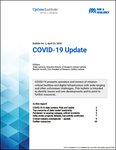The months since the start of the Covid-19 pandemic have posed challenges for employees, customers and suppliers. We have all had to make significant changes to the way we work and go about our daily lives, but everyone has acted admirably in working together in this global crisis. We have not only coped with the changing conditions the virus has thrown at us but found new ways to improve existing processes. Some of those changes will continue to deliver benefits even as the pandemic fades.
Several new procedures and approaches initiated in response to government restrictions and heightened biosecurity have proven so beneficial that we will maintain them even as enforced restrictions are eased. For example, enhanced hygienic regimes will help fight transmission of flu and common colds as well as Covid-19. Greater awareness of disinfection of high-touch areas, as well as personal responsibility for more frequent handwashing and sanitization as an expected behavior will be part of the ‘new normal’, leading to healthier, more infection-aware, populations.
Keeping things remote
The restriction of customer site visits that we enforced has also led to innovations in how we deliver some remote services. Reliance on ‘Remote Hands’ services has of course increased, but we’ve also improved the way we offer these services. We now routinely utilize video calls to give clients a real-time view of work as it is carried out, allowing for detailed step-by-step direction. Customers feel more in control and are opting for remote hands services more frequently. We are now examining further enhancements in this area as customers look for more cost-efficient, timely and sustainable ways of undertaking routine tasks at our sites.
These approaches have also proven effective in other areas of customer service. Prior to Covid, handover of facilities involved customers visiting in person to witness verification testing to show each system working as specified. Often this meant customers flying experts in from around the world – expensive in time, money and environmental impact. Since Covid we’ve been doing handovers via video link, often to customers located in several different geographies simultaneously. This is much faster and allows detailed real-time dialogue with several stakeholders, that may never have had time to travel in person, improving the overall process.
The same is true for site visits in the sales process. Larger groups can be shown around our sites virtually, and more people can ask detailed questions with an engineer conducting the tour via video feed. During this period of heightened visiting restrictions, it is the only way to visit a site – in the future, it might prove to be the preferred option for many prospects.
The value of remote monitoring has also been underlined. Initially used predominantly to manage power distribution, the remote monitoring system has now been expanded to analyze every aspect of the facility, from performance of individual fans to the temperature in specific racks. Using this constant stream of data (from sensors reporting every millisecond) we improve efficiency by increasing preventative maintenance and streamline on-site visits.
Some advantages have been more subtle and more unexpected. One concern was that the morale of teams and individuals might be negatively impacted by the reduction in person to person contact and socializing. We acted fast and with ingenuity to mitigate this risk as much as possible by engaging staff through internal virtual social events and fun competitions – even so, understandably, individuals do look forward to the in person social interaction.
New processes
We have also seen how working to overcome adversity has brought the staff closer. People across the organization have taken on new responsibilities and exercised decision-making of the highest order to ensure we continue to do the best for our customers and continue delivering on our stringent SLAs. This has proven to be highly empowering and has helped management to re-define mandates and processes to better support customers and staff. Personally, I have found that although I’ve not been able to visit all sites in person during this period, by managing my time differently and using video calling I have increased my interaction with all of my team. Decisions are made much faster and directly by the onsite team that are closer to the customers on that specific site. We have become an even better, more agile and responsive organization as a result.
When we first implemented our Covid-19 restrictions in late February our initial strategy was to focus on the business-critical services needed to support our customers operations. However, we quickly found that the newly implemented policies and routines still allowed us to accomplish everything that we’d planned to do prior to the pandemic. Using the latest technologies, we have been able not only to maintain our high service levels, but we have simultaneously reengineered processes to improve them. Now we are building on these improvements and evaluate what more we can do to reinvent a heightened best practice for data center management for the future.





